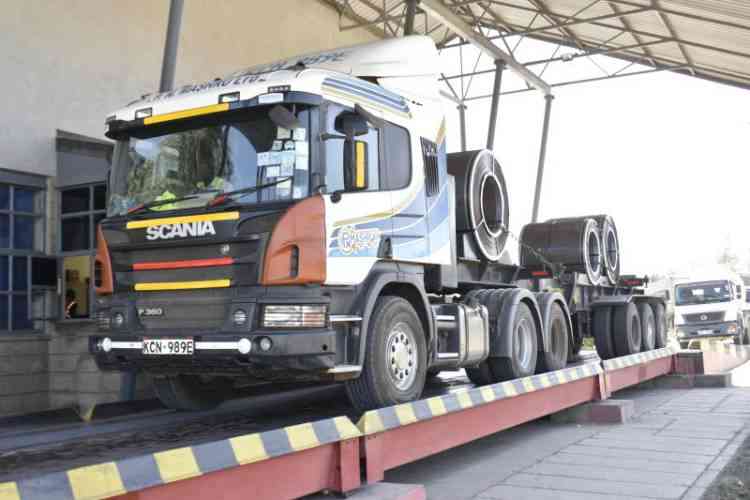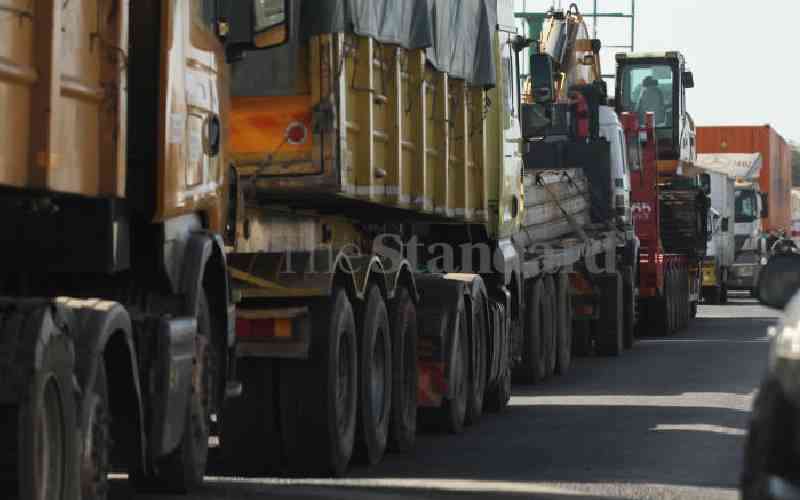
You must have seen a truck or trailer with an empty used bottle tied and protruding from one of the wheel nuts of the heavy machine.
It is easy to dismiss the sight but to the truck drivers, the empty bottles play a key role in their daily operation as they transport cargo both locally and regionally.
Many of the long-distance drivers opt to suspend part of the axles of their trucks (often referred to as lifting) which in turn saves them fuel.
Also, by lifting one axle, the drivers manage to carry more load than allowed by the law.
(Some trailers have up to six axles).
While driving, the trailer drivers use their side mirrors to countercheck and confirm if the axel is lifted or not and this will be visible since the tied-up bottles will be in motion and will not rotate if the axel has been lifted.

The Standard engaged Salim Muoki, 48, a trailer driver with 13 years of experience who has been shuttling with tons of goods between Mombasa, Busia, and Rwanda on a Mercedes truck.
“We indeed save fuel by suspending an axle for a truck with liftable axles since by so doing, it reduces the contact with the road and also the overall rolling resistance,” Muoki stated.Technically, with fewer tires in contact with the surface, any engine doesn't have to work as hard to move the vehicle forward, thus saving fuel.
Some trucks are equipped with self-steering lift axles or tag axles that can be raised when the truck is not fully loaded, hence saving on fuel.
When the truck is carrying less weight and doesn't need the additional axle for weight distribution, lifting it can reduce the overall weight on the road, further reducing fuel consumption.
“Once at the weighbridge, the trailer is supposed to have all the axles on the ground, lifting the axles equates to uneven distribution of the weight in the trailer, and hence one can be fined a huge sum of money,” the truck driver explained.
Our motoring team engaged Samuel Kumba, one of the Directors at the Kenya National Highways Authority (KeNHA) which manages the various weighbridges stationed across the country.“When they lift the axles, this affects the distribution of the weight across the truck and hence affects our roads. When at the weighing station, all the axles must be engaged or else if the truck is overloaded, one can be fined up to Sh400,000,” Kumba told The Standard.

According to the Traffic Act Section 58, any person who drives or uses on a road a vehicle in contravention of the provisions of section 55 or section 56 shall be guilty of an offense and liable to a fine not exceeding Sh400,000 or to imprisonment for a term not exceeding two years or both.
“The fine can exceed what we charge for laws contravened on the Northern Corridor. When it comes to the East African Community Vehicle Load Control Regulations 2018, one can be charged up to Sh40 million,” said Kumba.
In accordance with section 17 (6) of the Act, an overloaded vehicle shall be detained without charge for three days and thereafter a fee of fifty dollars (Sh6,450) shall be charged for each extra day of detention.
Weighbridges are crucial for ensuring trucks adhere to legal weight limits, which helps protect roads, bridges, and public safety.
 The Standard Group Plc is a multi-media organization with investments in media platforms spanning newspaper print
operations, television, radio broadcasting, digital and online services. The Standard Group is recognized as a
leading multi-media house in Kenya with a key influence in matters of national and international interest.
The Standard Group Plc is a multi-media organization with investments in media platforms spanning newspaper print
operations, television, radio broadcasting, digital and online services. The Standard Group is recognized as a
leading multi-media house in Kenya with a key influence in matters of national and international interest.











